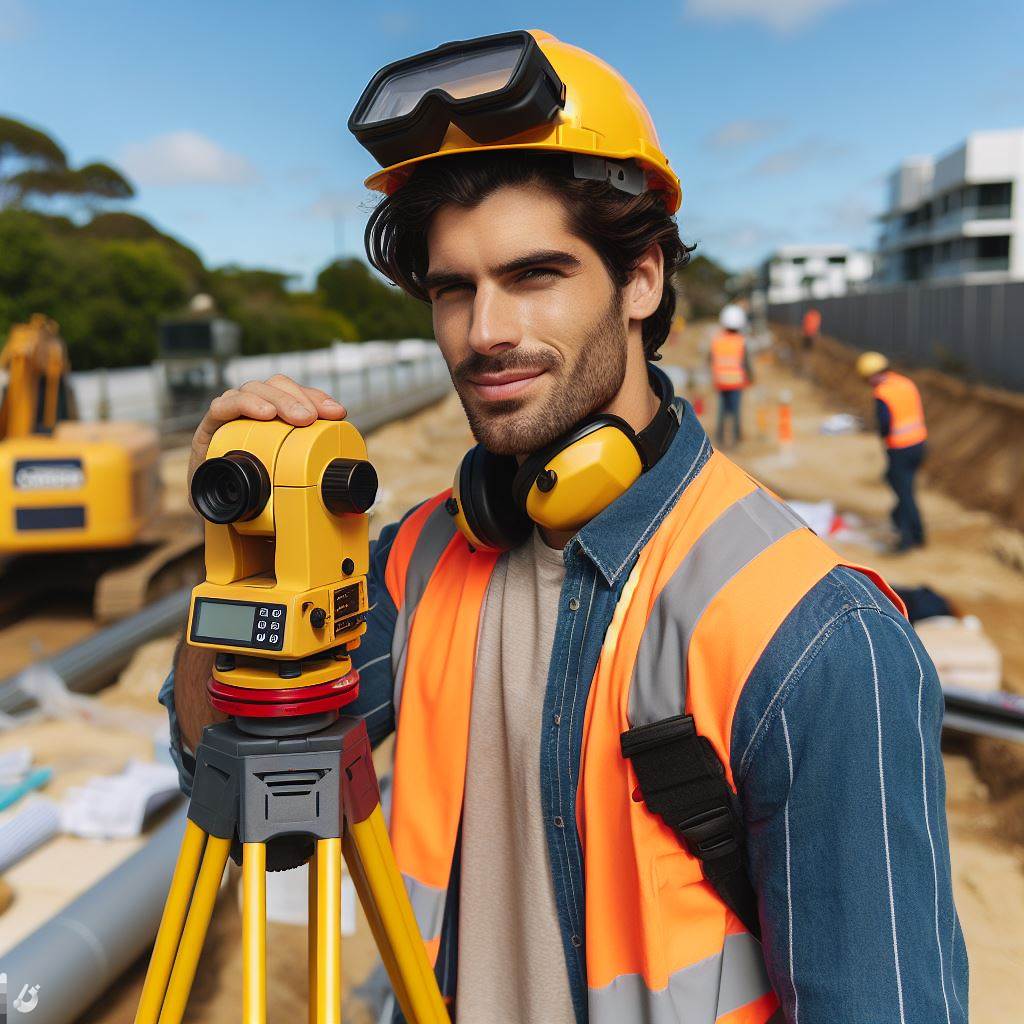Introduction
A surveyor plays a crucial role in various industries, providing accurate measurements and mapping.
They are responsible for determining property boundaries, creating maps, and conducting surveys for construction projects and infrastructure development.
Their expertise is essential in ensuring the proper allocation of land resources and maintaining the integrity of structures.
Without surveyors, many industries would face challenges in planning, designing, and executing projects.
In the construction industry, surveyors are involved in the initial planning stages, conducting topographic surveys, and identifying suitable locations for buildings and infrastructure.
They collaborate with architects, engineers, and contractors to ensure accurate measurements and precise positioning of structures.
In the real estate sector, surveyors help determine property boundaries, ensuring buyers and sellers have clear boundaries and avoiding any disputes.
They also provide land surveys for new developments, such as subdivisions, and establish easements for utilities and access rights.
Surveyors also play a vital role in infrastructure projects.
They perform topographic surveys to assess the feasibility of constructing roads, bridges, and tunnels.
Additionally, they conduct geodetic surveys to establish GPS control points, which are crucial for accurate mapping and navigation.
In the mining industry, surveyors assist in determining mineral boundaries, conducting volumetric calculations, and monitoring excavation progress.
Their precise measurements help optimize resource management and safety protocols.
Surveyors also contribute to environmental conservation efforts by conducting surveys to establish wildlife habitat boundaries and monitor land erosion and vegetation growth.
Surveyors are indispensable across various industries, ensuring accurate measurements, proper land management, and successful project execution.
Their expertise is vital for maintaining efficiency, minimizing disputes, and promoting sustainable development.
Without surveyors, industries would face significant challenges in planning and executing projects effectively.
Overview of a surveyor’s role
Definition and purpose of surveying
Surveying is the process of measuring and mapping the Earth’s surface to establish boundaries, distances, and elevations.
It is an essential field in various industries, including land development, construction, engineering, and environmental management.
Types of surveying
There are different types of surveying, each serving a specific purpose:
Land surveying
This type of surveying involves measuring and mapping the Earth’s surface to determine property boundaries, create land subdivision plans, and establish legal boundaries for land ownership.
Construction Surveying
Surveyors in construction play a crucial role in setting out and monitoring the position, elevation, and alignment of structures during the construction process.
This ensures that buildings and infrastructure are built according to design plans and specifications.
Geodetic surveying
Geodetic surveyors use sophisticated techniques and equipment to measure large areas of the Earth’s surface, taking into account the curvature of the Earth.
This type of surveying is essential for mapping large regions, measuring tectonic plate movements, and establishing reference points for accurate positioning systems.
Topographic surveying
Topographic surveyors create detailed maps or models of the Earth’s surface, including natural features like hills, valleys, rivers, and trails.
These surveys are vital for urban planning, environmental management, and infrastructure development.
Tools and equipment
To perform their duties, surveyors utilize an array of specialized tools and equipment:
- Global Positioning System (GPS): This satellite-based positioning system allows surveyors to determine precise coordinates and perform accurate measurements.
- Total Station: A total station is an advanced surveying instrument that combines electronic theodolite and distance measurement capabilities. It is used to measure angles and distances with high accuracy.
- Laser scanners: Laser scanners emit laser beams to measure distances, providing three-dimensional data for creating detailed maps or models.
- Drones: Unmanned aerial vehicles equipped with cameras or LiDAR sensors can quickly gather aerial data for surveying large areas or sites that are difficult to access.
- Surveying software: Specialized software applications are used for data processing, calculations, mapping, and creating survey reports.
Additionally, surveyors utilize traditional tools such as measuring tapes, levels, theodolites, and compasses to perform specific tasks.
A day in the life of an Aussie surveyor involves a combination of fieldwork and office work. In the field, surveyors venture outdoors, often working in remote or challenging environments.
They set up equipment, take measurements, use GPS and total stations, and record data.
In the office, surveyors process the collected data, analyze measurements, create maps and plans, and prepare survey reports.
They collaborate with engineers, architects, and other professionals to ensure accuracy in their work.
Lastly, surveyors play a vital role in shaping our built environment by providing accurate spatial information that facilitates development, construction, and land management processes.
Morning Routine: A Day in the Life of an Aussie Surveyor
As an Aussie surveyor, my morning routine is crucial to ensure a productive day ahead. Here’s a glimpse into what my mornings typically look like:
Waking up and preparing for the day
- My alarm goes off at 5:30 am, signaling the start of a new day.
- I quickly get out of bed and freshen up with a splash of cold water to wake myself up.
- After a quick shower, I put on my surveyor gear which includes a high-visibility vest and sturdy boots.
- Next, I head to the kitchen to have a hearty breakfast to fuel me for the physically demanding tasks ahead.
- I indulge in a hot cup of coffee and grab a nutritious granola bar to eat on the go.
Traveling to the survey site
- By 6:30 am, I’m ready to hit the road to reach the survey site, which can be located anywhere within the region.
- I hop into my trusty surveyor’s van, checking that I have all the necessary equipment and paperwork.
- The drive to the survey site can vary in length, depending on its distance from my office.
- During the journey, I listen to some upbeat music or catch up on my favorite podcast to keep myself motivated.
Setting up the equipment and conducting preliminary checks
- Upon arrival at the survey site, usually around 7:30 am, I park my van nearby and unload all the required surveying equipment.
- I meticulously arrange the equipment, making sure everything is in its proper place and easily accessible.
- Before getting started, I perform a series of preliminary checks on the equipment to ensure its accuracy.
- This includes calibrating the GPS device, checking the levels on the theodolite, and inspecting the range finder.
- Once satisfied with the equipment’s functionality, I double-check my survey instructions and plan for the day.
And that sums up the morning routine of an Aussie surveyor! Starting the day with a clear mind and well-prepared equipment sets the tone for a successful surveying mission.
Stay tuned for the next section discover the exciting challenges and experiences I encounter as the day unfolds!
Fieldwork
Tasks performed by surveyors
Detailing the tasks performed by surveyors, conducting measurements and collecting data using specific methods and techniques for accurate results.
Being an Aussie surveyor is not just about crunching numbers and looking at maps; it’s a dynamic and exciting profession that requires great attention to detail, problem-solving skills, and a love for the outdoors.
In this section, we will take a closer look at a typical day in the life of an Aussie surveyor, focusing on the fieldwork they undertake.
Fieldwork is an essential part of a surveyor’s job.
It involves going out to various locations, surveying land, and collecting data for different purposes.
This could be for building projects, land development, environmental assessments, or even for legal purposes.
Your Personalized Career Strategy
Unlock your potential with tailored career consulting. Get clear, actionable steps designed for your success. Start now!
Get StartedConducting measurements and collecting data
One of the primary tasks of a surveyor during fieldwork is to conduct measurements.
This involves using specialized tools and equipment such as total stations, GPS receivers, and laser scanners.
These instruments are used to measure distances, angles, elevations, and coordinates with high accuracy.
The data collected during measurements is crucial for making precise maps, determining property boundaries, and calculating areas and volumes.
Surveyors must ensure that the measurements they take are accurate and reliable, as any errors could have significant consequences for the projects they are working on.
Using specific methods and techniques for accurate results
Surveyors also use specific methods and techniques to ensure accurate results.
For example, they might use leveling techniques to determine the elevation of different points on the land.
This information is crucial for designing drainage systems, roads, or any other construction project that requires a precise understanding of the topography.
Another technique commonly used by surveyors is the use of trilateration or triangulation.
This involves measuring angles and distances between known points to determine the position of unknown points.
These techniques are particularly useful when surveying large areas or when access to certain locations is limited.
In addition to measurements, surveyors also collect various types of data during fieldwork.
This could include photographs, videos, and physical samples such as soil or vegetation.
This data is then analyzed and used for different purposes, such as creating digital elevation models, identifying environmental features, or assessing the suitability of land for development.
Fieldwork as a surveyor is not without its challenges.
Surveyors often have to work in harsh and remote environments, facing extreme weather conditions or difficult terrains.
They need to be physically fit and mentally prepared to cope with these challenges and ensure the accuracy of their work.
Moreover, surveyors must also possess excellent communication skills as they often have to interact with clients, landowners, and other professionals involved in the projects.
Effective communication is vital in understanding the project requirements, explaining the surveying process to stakeholders, and ensuring that everyone is on the same page.
Basically, a day in the life of an Aussie surveyor is far from mundane.
Fieldwork is a critical part of their job, involving a range of tasks such as conducting measurements, collecting data, and using specific methods and techniques.
With each project they undertake, surveyors play a vital role in shaping the future of the Australian landscape.
Challenges Faced as an Aussie Surveyor
Dealing with Unpredictable Weather Conditions
- Aussie surveyors often encounter unexpected weather changes during their work.
- Extreme heat, heavy rain, or strong winds can disrupt surveying operations and cause delays.
- Surveyors must constantly adapt to the weather conditions and plan their schedules accordingly.
- Safety precautions, such as wearing appropriate gear and monitoring weather forecasts, are crucial.
- Despite the challenges, surveyors strive to complete their work efficiently and meet deadlines.
Working in Remote and Challenging Terrains
- Aussie surveyors often find themselves working in remote and difficult-to-access areas.
- They may have to deal with rough terrains, dense vegetation, or rugged landscapes.
- Navigating through these areas can be physically demanding and time-consuming.
- Surveyors utilize specialized equipment and tools to measure and mark points accurately.
- They may also need to hike long distances or use vehicles suitable for off-road conditions.
Coordinating with Other Professionals On-Site
- Collaboration with fellow professionals, such as architects, engineers, and construction workers, is essential.
- Surveyors communicate and coordinate with these teams to ensure accurate data collection.
- They need to align their work with the project’s overall objectives and timelines.
- Sharing information and resolving any discrepancies is crucial for smooth progress on-site.
- Aussie surveyors excel in effective teamwork, fostering strong relationships to ensure project success.
In fact, being an Aussie surveyor presents various challenges that require resourcefulness, adaptability, and effective communication skills.
Dealing with unpredictable weather conditions, working in remote and challenging terrains, and coordinating with other professionals on-site are all part of their demanding day-to-day tasks.
Despite the difficulties, these skilled individuals persevere to provide accurate measurements and contribute to the successful completion of projects throughout Australia.
Lunch break
Taking a break and enjoying some downtime
The lunch break serves as a pivotal interlude, providing a respite for individuals to unwind and savor moments of relaxation.
It becomes an opportune time for fostering camaraderie and team cohesion as colleagues gather to discuss the morning’s progress, exchanging insights and perspectives.
Amidst the convivial atmosphere, there is a natural flow of communication, allowing for a deeper understanding of the team’s dynamics and collaborative efforts.
The morning’s progress with colleagues
These midday conversations not only serve as a reflective space to evaluate achievements and challenges but also contribute to the overall synergy within the workplace.
As colleagues share their experiences, ideas, and future plans, a sense of camaraderie blossoms, fostering a positive work environment.
Preparing for the afternoon tasks
Simultaneously, the lunch break becomes a preparatory phase for the upcoming afternoon tasks.
Individuals utilize this time to strategize, plan, and organize their thoughts, ensuring a seamless transition into the latter part of the day.
Whether it’s reviewing notes, prioritizing tasks, or setting goals, this deliberate preparation allows for a more focused and efficient approach to the tasks at hand.
In general, the lunch break transcends beyond a mere pause for meals; it evolves into a multifaceted intermission, encompassing relaxation, socialization, and strategic planning.
It not only nourishes the body but also nurtures the collaborative spirit, contributing to a thriving and cohesive work culture.
Afternoon tasks
Continuing with data collection and measurements
Once the midday break is over, an Aussie surveyor gets right back to work, continuing with the tasks for the afternoon.
This phase of their day involves several activities that require focus and attention to detail.
The first task for the afternoon is to continue with data collection and measurements.
This is a critical step in the surveying process, as accurate and precise measurements are crucial for the success of any project.
The surveyor diligently goes about this task, using advanced equipment and technology to gather the necessary data.
As they proceed with data collection, it is not uncommon for surveyors to encounter issues or errors.
This could be due to technical glitches, environmental factors, or human error.
Regardless of the cause, it is their responsibility to promptly resolve these problems to ensure the accuracy of the data collected.
Resolving any issues or errors encountered
Resolving issues requires problem-solving skills and the ability to think on one’s feet.
The surveyor analyzes the situation, identifies the root cause of the problem, and implements appropriate solutions.
This could involve adjusting equipment settings, re-measuring certain points, or seeking assistance from colleagues or experts.
Adapting to changing circumstances on the field
Furthermore, an Aussie surveyor needs to be adaptable to changing circumstances on the field.
Project conditions can change unexpectedly, presenting new challenges and requirements.
The surveyor must be flexible and ready to adjust their plans accordingly.
For example, if there are sudden changes in the terrain or weather conditions, the surveyor must adapt their measurement methods or schedule.
They may need to use different equipment or techniques to overcome these challenges and ensure accurate results.
Additionally, the surveyor must be able to cope with time constraints and pressure.
Sometimes, projects have strict deadlines, and delays can have significant implications.
In such cases, the surveyor must efficiently manage their time and prioritize tasks to meet the project timelines.
Overall, the afternoon tasks of an Aussie surveyor are just as important as their morning duties.
Continuing with data collection, resolving issues, and adapting to changing circumstances demonstrate their dedication and professionalism in ensuring the accuracy and success of their surveying projects.
Read: Architecture Licensing in Australia Explained
Interacting with clients
Interacting with clients is an essential part of a surveyor’s job. Meeting with clients on-site allows for a firsthand understanding of their needs and concerns.
Addressing these concerns and requirements is crucial in building a strong working relationship. Effective communication of survey results ensures that clients fully comprehend the findings.
Meeting with clients on-site
When meeting with clients on-site, a surveyor must create a positive and professional impression. Dressing appropriately and arriving on time are essential in establishing credibility and trust.
A neat and organized appearance gives off an impression of reliability and competence.
Addressing their concerns and requirements
During the meeting, actively listening to the client’s concerns and requirements is crucial.
Engaging in a two-way conversation allows the surveyor to fully understand the client’s needs and expectations.
Taking notes during the conversation helps in capturing important details that need to be addressed later.
Communicating survey results effectively
After gathering all the necessary information, the surveyor must effectively communicate the survey results to the clients.
This involves presenting the findings in a clear and understandable manner.
Using visual aids such as charts, graphs, or maps can help simplify complex information and make it easier for clients to interpret.
In addition to presenting the survey results, the surveyor should also address any questions or concerns the clients may have.
Providing detailed explanations and offering solutions to any issues that arise demonstrates the surveyor’s expertise and commitment to customer satisfaction.
Sometimes, surveyors may encounter clients who have difficulty understanding technical terminology or complex survey data.
In such cases, it is the surveyor’s responsibility to simplify the information, using layman’s terms if necessary.
This ensures that the clients fully grasp the significance of the survey results and can make informed decisions based on them.
Maintaining open lines of communication with clients is integral to a successful client-surveyor relationship.
Promptly responding to phone calls, emails, or any other form of correspondence helps in building trust and demonstrating the surveyor’s dedication to providing excellent service.
Regularly updating clients on the progress of their project also shows transparency and professionalism.
Aside from direct interactions with clients, surveyors often collaborate with other professionals, such as architects, engineers, or government officials.
Effective communication with these stakeholders ensures that all parties are on the same page and can work together smoothly.
Collaborative meetings allow for the exchange of ideas and the resolution of any conflicts or challenges that may arise.
Generally, interacting with clients is a vital aspect of a surveyor’s daily routine.
Meeting with clients on-site, addressing their concerns and requirements, and effectively communicating survey results are key responsibilities.
Building strong relationships and providing outstanding customer service are essential for a successful surveying career.
Stand Out with a Resume That Gets Results
Your career is worth more than a generic template. Let us craft a resume and cover letter that showcase your unique strengths and help you secure that dream job.
Get HiredRead: Challenges Faced by Modern Architects

Wrapping up the day
Finalizing data collection
As the day draws to a close, a systematic and thorough process unfolds to bring closure to the day’s fieldwork activities.
This encompasses the intricate task of finalizing data collection, where meticulous attention is given to ensure the accuracy and completeness of the gathered information.
Researchers or field professionals engage in a comprehensive review, cross-checking and validating data points, ensuring that all relevant details have been captured with precision.
Disassembling equipment and packing up
Simultaneously, the post-fieldwork ritual involves the careful disassembly of equipment utilized throughout the day.
Each piece is handled with precision and care, emphasizing the importance of equipment maintenance and preservation.
Items are stowed away thoughtfully, considering both their safety and future use, contributing to the longevity and efficiency of the tools.
The subsequent step in this winding-down process involves the packing up of the fieldwork site.
Whether it’s securing samples, organizing notes, or restoring the environment to its original state, this phase reflects a commitment to environmental responsibility and leaving minimal impact on the surroundings.
Traveling back to the office or home
Following the meticulous conclusion of fieldwork, individuals embark on their journeys back to the office or their respective homes.
The return trip becomes a reflective juncture, allowing time for professionals to assimilate the day’s experiences, contemplate findings, and strategize for any subsequent steps.
It also marks the physical transition from the dynamic field environment to the familiar surroundings of the office or home.
Wrapping up the day involves more than concluding fieldwork; it requires careful attention to detail, maintaining equipment, being environmentally conscious, and transitioning to reflection and planning.
Read: Historic Preservation in Australian Architecture
Discover More: Civil Engineering Degrees: Best Aussie Unis
Additional responsibilities
Being a surveyor in Australia is a rewarding and challenging career that requires a unique set of skills. A day in the life of an Aussie surveyor is filled with diverse tasks and responsibilities.
Let’s take a closer look at what their typical day looks like:
Morning Routine
- Start the day by reviewing project plans and schedules to prioritize tasks.
- Prepare equipment, tools, and vehicles needed for the surveying work.
- Coordinate with the team and assign specific roles and responsibilities for the day.
- Double-check safety protocols and ensure all necessary protective gear is worn.
- Head to the survey site, often located in remote or challenging terrains.
Fieldwork
- Set up surveying instruments, such as total stations, GPS receivers, and laser scanners.
- Collect accurate data by measuring distances, angles, elevations, and boundaries.
- Use advanced technology and software for mapping, geospatial analysis, and data management.
- Deal with unforeseen challenges like extreme weather conditions or difficult access to sites.
- Collaborate with engineers, architects, and construction teams to ensure accurate measurements and markers.
Post-fieldwork Tasks
- Perform data analysis and process the collected survey data using specialized software.
- Prepare detailed reports, maps, and charts to present the findings and interpretations.
- Review and cross-check the accuracy of the survey results to ensure maximum precision.
- Collaborate with colleagues to resolve any discrepancies or inconsistencies in the data.
- Respond to client inquiries and provide expert advice on surveying matters.
Attending Meetings
- Participate in project meetings with clients, architects, engineers, and other stakeholders.
- Provide expert input and advice on land boundaries, zoning regulations, and legal requirements.
- Collaborate with team members and share updates on the progress of ongoing surveys.
- Discuss challenges and propose innovative solutions to ensure project success.
- Present survey findings and recommendations to clients and project decision-makers.
Professional Development
- Stay updated with the latest advancements in surveying technology and techniques.
- Attend training sessions, workshops, and conferences to enhance skills and knowledge.
- Engage in continuous learning and seek professional certifications and accreditations.
- Network with industry peers and join professional surveyor associations.
- Contribute to research and development in the field of surveying through publications or presentations.
Being an Aussie surveyor requires not only technical expertise but also excellent communication and problem-solving skills.
They play a crucial role in various industries, including construction, engineering, land development, and environmental management.
Every day brings a new challenge and an opportunity to contribute to the growth and progress of Australia’s built environment.
Read: Surveying 101: An Aussie’s Intro to the Field
Delve into the Subject: Land Surveying: Australian Legal Aspects
Find Out More: Mechanical Engineering Graduates’ Guide
Conclusion
In closing, being a surveyor involves a variety of day-to-day activities such as conducting measurements, analyzing data, and creating reports.
Surveyors play a crucial role in various industries, including construction, engineering, and urban planning, by providing accurate and precise measurements.
They help ensure the success of projects by providing essential information for design, development, and land use planning.
Transform Your LinkedIn for Maximum Impact
Elevate your professional brand with a LinkedIn profile that attracts recruiters, showcases your expertise, and maximizes opportunities. Stand out in your industry with a profile built for success.
Boost ProfileHowever, being a surveyor also comes with its challenges. They often work outdoors in various weather conditions and face physical demands.
Additionally, they need to possess strong analytical and problem-solving skills to interpret data and solve complex measurement issues.
Surveyors also need excellent communication skills to collaborate with clients, engineers, and other professionals involved in the project.
In essence, surveyors are vital professionals in many industries, and their work is essential for accurate construction and development.
They contribute to the growth and advancement of society by ensuring that projects are built on sound foundations.
Despite the challenges they face, surveyors play a crucial role in shaping our cities and infrastructure, making them indispensable in modern society.




